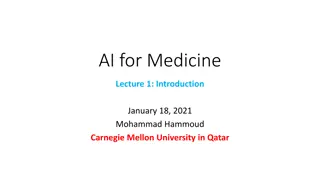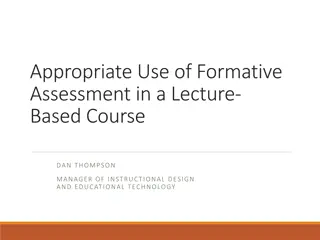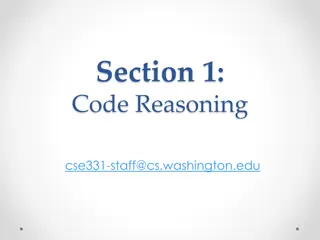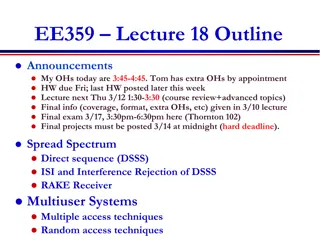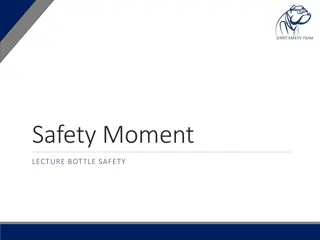
Effective Project Reporting Tips and Guidelines
Discover key insights on preparing project reports, understanding what to write, how to write, and submission methods for project analysis in 2012-2013. Learn about structuring the final project report, requirements document, and project overview based on reputable sources. Dive into the initial project stages, from the introduction to project description and specific goals, with a focus on project scope and scenarios. Enhance your project reporting skills with valuable information and practical advice.
Download Presentation

Please find below an Image/Link to download the presentation.
The content on the website is provided AS IS for your information and personal use only. It may not be sold, licensed, or shared on other websites without obtaining consent from the author. If you encounter any issues during the download, it is possible that the publisher has removed the file from their server.
You are allowed to download the files provided on this website for personal or commercial use, subject to the condition that they are used lawfully. All files are the property of their respective owners.
The content on the website is provided AS IS for your information and personal use only. It may not be sold, licensed, or shared on other websites without obtaining consent from the author.
E N D
Presentation Transcript
PREPARING THE PROJECT REPORTS Analyseproject 2012-2013 Miriam Ghijsen (Brielmann)
Overview What to write How to write How to submit
What to write The final project report Is the requirements document for your project (plus your reflections summary and lessons learned) Is built up week by week Recap: Requirements document (Sommerville, 1995) Project Reports overview (Korojelo, 2012a)
The Requirements Document See Sommerville (1995) slides
Final Report Content (2012) Korojelo, 2012a
1. Introduction Start with the discussion of the general area you are working on i.e. inventory management, business dashboard, reservation systems, etc. General overview of what is the area about Korojelo, 2012a
2 Project Description Detailed description of your specific project Korojelo, 2012a
2.1 Goals Detailed description of the goals of your project The goals should be precisely stated e.g. The project aims at developing a dynamic web based system that will keep track of customer information and sales Korojelo, 2012a
2.1 Project Scope The projects you are doing are very extensive generally, here provide explanation of the scope of your project o what exactly will you be able to cover in the project and what will you not cover o Scope may also include which steps of system development will you cover and what will you not cover ( i.e. requirement, specification and modelling, but not implementation) Korojelo, 2012a
2.3 Scenarios This can be as-is or visionary scenarios Describe at least one in the first report
2.4 Stakeholders and Intended Users Provide descriptions of the stakeholders and users of the system Do not go into details on what each stakeholder and user will do, just provide a brief explanation of the roles Korojelo, 2012a
2.5 Context Diagram The context diagram as presented
2.6 Elicitation Techniques Which elicitation techniques are you going to use?
3. Conclusion & Future work Conclude your work by summarizing what you have done in the project (and what lessons you learned) Provide a short description of the remaining work (next steps) Korojelo, 2012a
References and Glossary Provide a list of references you use in your work (see below) Provide a list of terms with definition Keep updating references and glossary Korojelo, 2012a
How to write Part of the grade is based on format and style Writing style (Afsarmanesh, 2012) References (Korojelo, 2012b)
Writing Style Be precise and justify what you state (either by reasoning about it, or giving a reference) Do not say things such as: over the years something has happened specify starting when and the duration, e.g. in recent decades, Write formally, e.g. isn t, didn t, haven t, etc. are not good to use in reports Tense of the verbs the best approach always is to use present tense Afsarmanesh, 2012
What is referencing? Referencing is used to tell the reader where ideas from other sources have been used in your work. There are many reasons why it is important to reference sources correctly: It shows the reader that you can find and use sources to create a solid argument It properly credits the originators of ideas, theories, and research findings It shows the reader how your argument relates to the big picture Failure to properly acknowledge sources is called plagiarism, and it can carry significant academic penalties Korojelo, 2012b
What needs to be referenced? Whenever an work uses words, facts, ideas, theories, or interpretations from other sources, that source must be referenced. Referencing is needed when: You have copied words from a book, article, or other source exactly (quotation) You have used an idea or fact from an outside source, even if you haven't used their exact wording (paraphrasing and summarizing) Korojelo, 2012b
Citation A quotation from or reference to a book, paper, or author, esp. in a scholarly work. By citing the work of acknowledge and respect the intellectual property rights of that researcher Example: When testing the usability of a website, it is necessary to gather demographic information about the users (Lazar, 2006). a particular scholar you In this example, (Lazar, 2006) tells the reader that this information has come from a source written by Lazar, which was published in 2006. Korojelo, 2012b
Referencing Styles These are rules and standards to follow when formatting citations and references Many students find referencing quite intimidating at first Famous referencing styles include: APA (American Psychological Association) Chicago Manual of Style Harvard IEEE (Institute of Electrical and Electronics Engineers) We will get an overview of the APA style Korojelo, 2012b
About the APA Style It includes everything related to writing about your work, including: - How pages are set up - How to cite sources - References - etc. See Manual of the American Psychological Association (http://www.apastyle.org/) or Google ;-) Korojelo, 2012b
Citing while paraphrasing Scott (1992) identified Several researchers (Anthony, 1990; Gregory & Jacobs, 1985; Polk et al., 1980) reported Or at the end of a sentence paraphrased from another work (Scott, 1992). Korojelo, 2012b
Citing while quoting You need to put the author last name(s) and date, like while paraphrasing, but also the page numbers or paragraph numbers (for online sources). Example: the research findings clearly indicate support for the hypotheses (Douglass, 1986, p. 55). Korojelo, 2012b
List of References Required if you cite any sources in your paper Every source cited in your paper must appear on the reference list, and every entry in your reference list must be cited in your paper References and citation differs depending on the cited material, whether a: Book journal article Web page Thesis reports Etc. Korojelo, 2012b
Books Single-authored book Perloff, R. M. (1995). The dynamics of persuasion. Hillsdale, NJ: Erlbaum. Reissued book Newcomb, H. (Ed.). (1995). Television: The critical view (5thed.). New York: Oxford University Press. Dual-authored book Baran, S. J., & Davis, D. K. (1995). Mass communication theory: Foundations, ferment and future. Belmont, CA: Wadsworth. Essay or chapter in an edited book Bryant, J. (1989). Message features and entertainment effects. In J. J. Bradac (Ed.), Message effects in communication science (pp. 231-262). Newbury Park, CA: Sage. Korojelo, 2012b
Articles Single-authored article Garramone, G. M. (1985). Effects of negative political advertising: The roles of sponsor and rebuttal. Journal of Broadcasting & Electronic Media, 29, 149-159. Two or more authors (in article) Suzuki, S., & Rancer, A. S. (1994). Argumentativeness and verbal aggressiveness: Testing for conceptual and measurement equivalence across cultures. Communication Monographs, 61, 256-279. Korojelo, 2012b
University Provided Study Material Lecture / tutorial notes, etc. Online: Citation In examining the genre of fiction (St. Vincent Welch, 2009) Reference: St. Vincent Welch, S. (2009). Unit 8147 Writing short narratives, lecture 1, week 1: What is fiction? [Lecture PowerPoint slides]. Retrieved from http://learnonline.canberra.edu.au/ If not published: It is reported that ..... (N. M. Blampied, personal communication, May 5, 2011) Korojelo, 2012b
Sample Citation However, Wallace and Singer (1976) noted that facillima saepe non sunt optima accepit hoc. Also in similar studies it was observed that blah blah blah blah blah (Flory & Everist, 1977; Gentry, 1968; Killeen, 1979). Similarly, Flory (1969a) pointed out the problem of plures viri quam appellabant (p.384). Consistent with this view Schaal, Shahan, Kovera and Reilly (1998) note that babble babble babble pessimi copiis maius deum . For the present study I will look at the phenomenon mentioned first by Flory (1969b). Korojelo, 2012b
Sample Reference List Calvillo, D. (1999). The theoretical development of aggression. Retrieved August 21, 2002 from: http://www.csubak.edu/~1vega/dustin2.html Flory, R.K. (1969a). Attack behavior as a function of minimum inter-food interval. Journal of the Experimental Analysis of Behavior. 12,825-828. Flory, R.K. (1969b). Attack behavior in a multiple fixed-ratio schedule of reinforcement. PsychonomicScience, 16,383-386. Flory, R.K. & Everist, H.D. (1977). The effect of a response requirement on schedule- induced aggression. Bulletin of the PsychonomicSociety 9, 383-386. Gentry, W.D. (1968). Fixed-ratio schedule-induced aggression.Journal of the Experimental Analysis of Behavior 11,813-817. Korojelo, 2012b
References in the Report How much literature? 2 to 3 references related to the application case, 1 to 2 references related to requirements engineering topic
How to Submit The weekly reports: By Sunday, 24:00 (CET) You will get the weekly feedback by Wednesday morning Final report: at the exam event
END Any Questions?
List of References Afsarmanesh, H. (2012). Final Bachelor Project BSc Informatiekunde: Thesis Proposal Evaluation [Lecture PowerPoint slides]. Retrieved from http://www.science.uva.nl/FCN/teaching/2012-afstudeerproject- sem2/documents_files/research%20proposal%20comments.pdf Korojelo, S. (2012a). Analyseproject: Final Report Overview [Lecture PowerPoint slides]. Retrieved from http://www.science.uva.nl/FCN/teaching/Project_Analysis_2012/Practicu m%20Lectures/Lecture%203.5-%20Final%20Report%20Format.pptx Korojelo, S. (2012b). Analyseproject: Scientific Paper Writing [Lecture PowerPoint slides]. Retrieved from http://www.science.uva.nl/FCN/teaching/Project_Analysis_2012/Practicu m%20Lectures/Lecture%201.4%20- %20Scientific%20Papers%20Citation%20&%20Referencing.pptx Sommerville, I. (1995). Requirements Engineering [PowerPoint slides] (pp.11-14). Retrieved from: http://infolab.stanford.edu/cs446/Slides/re.ppt




